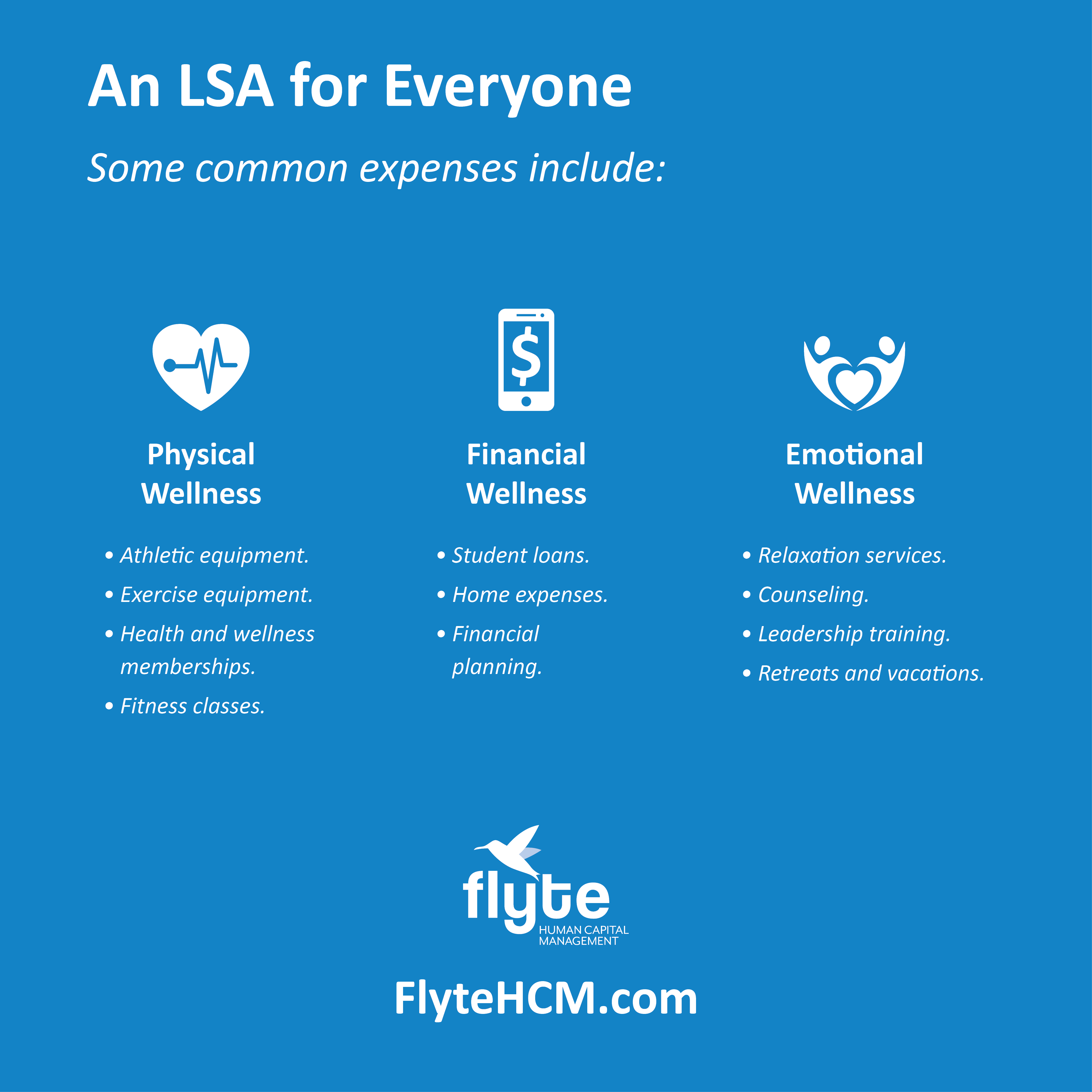
Fund employee well-being with a Lifestyle Spending Account (LSA)
In this highly competitive employment market, employees want and need more than wages and the traditional benefits employers currently offer. They would like support in other key areas of their lives to combat the challenges they face. Most haven’t heard about Lifestyle Spending Accounts (LSAs) which started gaining popularity in the past few years. LSA’s are a new benefit with an age-old concept at its foundation. Employers offer reimbursement for their employee’s out-of-pocket expenses such as gym memberships, home office supplies, and counseling to name a few.
Those with a history in benefits will say that’s exactly what a Health Savings Account (HSA), Flexible Spending Accounts (FSA), and Health Reimbursement Arrangements (HRA) are for, but each of them has something the LSA doesn’t, Health Accounts (HSA, FSA, HRA) are all tax-advantaged accounts.
Lifestyle Spending Accounts (LSA) are different in that there is NOT a tax-advantaged benefit. The obvious negative is that there are no savings on taxes, however, that’s where the dirt road ends, and pavement begins because there are no restrictions on LSAs regarding how much an employer can contribute and what that money is spent on.
Employers determine their budget and tailor their LSA to meet the needs of their staff. With an LSA they can target specific areas to assist with their employee’s Physical, Financial, and Emotional Wellness or all areas. Unlike adding a bonus or stipend to an employee’s paycheck an LSA guarantees that the money is used for what the employer would like it to be used for. The reimbursements are counted as taxable wages so there are few plan design considerations to account for, and employers seem to like the lack of reporting and accounting headaches associated with an LSA as opposed to a tax-advantaged Health Account.
How HSAs and LSAs Differ
LSAs add agility to your benefit plan and can easily be implemented to provide financial relieve in key areas not being address by your current benefits. While an HSA and LSA may look similar, there are key differences you’ll want to know about.
| LSA | HSA |
|---|---|
| Not pretax | Pretax Eligible |
| Common expenses: | Common expenses: |
|
|
| Provides funds for anything the LSA allows. | Provides funds to pay for a wide range of health and welfare expenses. |
Establishing an LSA
Establishing an LSA
LSA funds, while not tax-advantaged, will avoid the normal constraints imposed by tax-advantaged accounts such as an HSA or FSA. Because of this, LSA is both easy to set up and offers a wide variety of uses beyond the typical medical and dental expenses. Here is a quick overview of what it takes to set one up.
Employer Established Budget and Plan Design. The first decision is how much the company has budgeted for this benefit by employee class. A general rule of thumb is to always offer the same benefit to each worker in a particular class. The second decision is to determine when the monies will be available for reimbursement.
- How soon will my employees have access to their LSA contributions?
If $250 is the annual employer contribution towards their LSAs, the entire amount could be available to employees immediately.
Or, if you prefer the contribution to be distributed over the year you can spread the contributions out on a scheduled basis. i.e., per payroll, monthly, etc.
- Do my employees lose unused funds at the end of the year, or do they roll over?
Employers have the choice as to whether they’ll allow the funds to roll over to the next year or not. If you are not sure which is the best option, contact Flyte today and our team will gladly assist you with the setup process.
Tailor To Their Needs. Now that you have a budget and a plan for the money, now it’s time to tailor the funds to the needs of your staff. Some employers have a broad view of how that money can be used, and others have a very specific view.
Some employers will choose specific expenses such as fitness or nutrition expenses as the only expenses eligible under the benefit, while others believe the money is best spent on whatever the larger menu of benefits (fitness class, student loads, home expenses, or a leadership class). In any of these scenarios, employers have the flexibility to point that money in the direction they believe to be of the best impact on their employees’ lives.
Communicate. LSAs are an emerging employee benefit, so it’s safe to say that many employees have no clue what they are, or how they work. And if you’ve been around benefits for any amount of time, you know full well how challenging it can be to communicate timeless benefits like a medical or dental plan. We have found that the simpler the better when it comes to benefits, so make sure your plan design is simple and the information used to describe the benefit is even simpler.
Flyte offers the tools, resources, and support to provide a simple and easy-to-use benefit like a Lifestyle Spending Account. The Flyte Benefits App, for example, is a great tool that employees use to discover how their LSA works, file their claims, and chat with a member service specialist 24/7.
